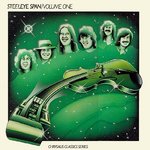> Steeleye Span > Records > Volume One
Steeleye Span: Volume One
 |
Volume One Chrysalis CHG 1004 (LP, UK, 1978) |
Tracks
Side 1
- The Blacksmith (Roud 816) (3.38)
- Female Drummer (Roud 226; G/D 1:182; Henry H497) (3.59)
- Jigs: Bryan O’Lynn / The Hag with the Money (3.17)
- One Night as I Lay on My Bed (Roud 672) (3.30)
- Dark-Eyed Sailor (Roud 265; Laws N35; G/D 5:1037; Henry H232) (5.57)
Side 2
- A Calling-On Song (1.13)
- Reels: Dowd’s Favourite / £10 Float / The Morning Dew (3.41)
- Four Nights Drunk (Roud 114; Child 274; G/D 7:1460; Henry H21ab) (3.04)
- All Things Are Quite Silent (Roud 2532) (2.37)
- Skewball (Roud 456; Laws Q22) (3.31)
- Lowlands of Holland (Roud 484; G/D 6:1116; Henry H180) (5.59)
#1, 4-6, 9 and 11 were originally released on
Hark! The Village Wait
#2 and 3 were originally released on
Please to See the King
#7, 8 and 10 were originally released on
Ten Man Mop or Mr Reservoir Butler Rides Again
Sleeve Notes
Steeleye Span: A Short History
Steeleye Span was the most successful, best-loved folk-rock band that Britain, or any other country, has produced. The band existed from the end of ’69 through to the spring of ’78. In the 100 months that Steeleye were together they managed to get through 724 gigs, three managers, three record companies and four line-ups, and won themselves one gold and four silver albums. They left behind ten albums—with the promise of one or two live albums still to be released—and attitudes to British folk music could never be quite the same.
Maddy Prior and Tim Hart were Steeleye’s best-known members, for they were the only two who survived the full eight years. But it was another folk-rocker, Tyger Hutchings (earlier with Fairport Convention, now with the Albions). who got the first line-up together, getting Tim and Maddy to join Gay and Terry Woods. The intention was “not to be a rock band—we wanted to be traditional musicians working with electric instruments.” All, apart from Tyger, had come from the folk scene and the first album was predictably muted. The band broke up without giving a single concert.
Steeleye Mark 2 did better—but was still far from perfect. The folk scene’s guitar superstar Martin Carthy came in to take the place of Gay and Terry, and a then-unknown fiddle-player, Peter Knight, was added later. The line-up made two albums, of which the first, Please to See the King, was a minor masterpiece—restrained, slightly solemn but with magnificent elaborate arrangements to traditional songs. On stage, alas, the band were not so good and sounded more like a group of talented individuals than an integrated unit. Again, Steeleye broke up.
This time, it was predicted that the group was finished, for the two main ‘names’—Hutchings and Carthy—were gone. Instead, Steeleye went on to become the only folk-rock supergroup. In came unknown bass-player Rick Kemp, in came unknown guitarist Bob Johnson, and the results were sensational. Steeleye was a full-time serious band now, and included those who understood rock music and amplification as well as those steeped in folk music. Traditional lyrics were still the starting point, but beyond that “the band progressed, so we forgot the folk limitations—we took songs and arranged them as we felt they should be arranged.” Sometimes the band gave an old song a new setting—as with All Around My Hat - and sometimes a completely new melody was added—as with Thomas the Rhymer. The band developed experimental theatrical skills to match their music, and soon they were as capable as any rock outfit of packing the big stadiums. It was only a matter of time before Steeleye added a drummer—and in Nigel Pegrum they got a flautist too.
Steeleye’s most famous line-up lasted five years—from January 1972 to December 1976, and was so successful that Tim Hart could claim “we are the first people to come out of the folk club scene since Ewan MacColl to actually do something to English folk music.” They travelled the world, took folk-rock into the best-selling lists, and only ran out of steam when it seemed they would keep going for ever. The band didn’t die, just faded away. They took the first half of 1977 off, and two members—Bob and Peter—never came back, and became involved in solo projects.
The final temporary, Steeleye included Martin Carthy (again) and John Kirkpatrick, two distinguished folk instrumentalists who came in—as Rick puts it—“to see the band off on the right note.” In the event they did far more than that, with John’s concertina and accordion playing (and morris dancing), and Martin’s guitar work giving Steeleye yet another fresh new image. This band was never intended to last (Martin and John had solo careers to get back to, and Maddy was about to embark on hers). Steeleye finally but triumphantly called it a day in March 1978, at the end of an extensive British tour.

